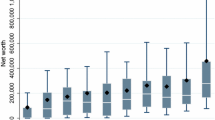Abstract
American prosperity in the second half of the 1980s together with the booming economy of the 1990s created the impression that American households have done well, particularly in terms of wealth acquisition. In this paper, we develop the concept of “asset poverty” as a measure of economic hardship, distinct from and complementary to the more commonly used concept of “income poverty.” We define a household with insufficient assets to enable it to meet basic needs (as measured by the income poverty line) for a period of three months to be asset poor. The results reveal that in the face of the large growth in overall assets in the U.S. and a fall in standard income poverty over the period from 1983 to 2001, the level of asset poverty increased from 22.4 to 24.5 percent. We also find that asset poverty rates for blacks and Hispanics are over twice those for whites; that asset poverty rates fall monotonically with both age and education; that they are much higher for renters than homeowners; and that by family type they range from a low of 5 percent for elderly couples to 71 percent for female single parents.
Similar content being viewed by others
References
Caner, A. and Wolff, E.N.: Asset poverty in the United States, 1984–1999: Evidence from the panel study of income dynamics, Working Paper No. 356, Levy Economics Institute of Bard College, Annandale-on-Hudson, NY, 2002.
Citro, C.F. and Michael, R.T. (eds.): Measuring Poverty: A New Approach, National Academy Press, Washington, DC, 1995.
D’Ambrosio, C. and Wolff, E.: Is wealth becoming more polarized in the United States?, Working Paper No. 330, Levy Economics Institute of Bard College, Annandale-on-Hudson, NY, 2001.
Haveman, R. and Mullikin, M.: Alternative measures of national poverty: Perspectives and assessment, In: Schokkaert (ed.), Ethics, Poverty and Inequality and Reform in Social Security, Ashgate Publishing Ltd., London, 2001.
Lerman, D.L. and Mikesell, J.J.: Impacts of adding net worth to the poverty definition, Eastern Economic J. XIV(4) (1988), 357–370.
Modigliani, F. and Brumberg, R.: Utility analysis and the consumption function: An interpretation of cross-section data, In: Kurihara (ed.), Post-Keynesian Economics, Rutgers University Press, New Brunswick, NJ, 1954.
Moon, M.: The Measurement of Economic Welfare: Applications to the Aged, Academic Press, New York, 1977.
Oliver, M.L. and Shapiro, T.M.: Black Wealth/White Wealth, Routledge Press, New York, 1997.
Rendall, M.S. and Speare, A., Jr.: Comparing economic well-being among elderly americans, Review of Income and Wealth 39(1) (1993) (March), 1–21.
Ruggles, P.: Drawing the Line: Alternative Poverty Measures and Their Implications for Public Policy, Urban Institute Press, Washington, DC, 1990.
Sen, A.: Inequality Reexamined, Russell Sage Foundation and Harvard University Press, Cambridge, MA, 1992.
U.S. Census Bureau: Experimental poverty measures 1990 to 1997, Current Population Reports, P60-205, June, 1999.
Weisbrod, B. and Hansen, W.L.: An income-net worth approach to measuring economic welfare, American Economic Review 58(5) (1968) (December), 1315–1329.
Wolff, E.N.: Recent trends in wealth ownership, 1983–1998, In: Shapiro and Wolff (eds.), Assets for the Poor: The Benefits of Spreading Asset Ownership, Russell Sage Foundation, New York, 2001.
Ziliak, J.P.: Income transfers and assets of the poor, Discussion Paper 1233-01, Institute for Research on Poverty, University of Wisconsin-Madison, 2001.
Author information
Authors and Affiliations
Rights and permissions
About this article
Cite this article
Haveman, R., Wolff, E.N. The concept and measurement of asset poverty: Levels, trends and composition for the U.S., 1983–2001. J Econ Inequal 2, 145–169 (2004). https://doi.org/10.1007/s10888-004-4387-3
Issue Date:
DOI: https://doi.org/10.1007/s10888-004-4387-3




